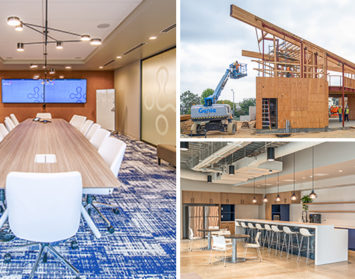First in the Project Design Elements Series

Exposed concrete flooring is a modern, trendy look that is gaining in popularity among our clients. When done properly, exposed and polished aggregate is a clean finish that adds distinctive character to a workspace. The use of exposed concrete flooring, and therefore the absence of carpeting or tile, also contributes to LEED certification.
However, exposing and treating the subsurface of an existing tile or carpet floor can be a costly and complicated process. In addition to the initial cost of removing the existing tile or carpet, there are a number of additional preparation costs that you may encounter once the subsurface is exposed in order to repair stains or cracks.
Even if the existing floor material does not need to be removed, you may still incur a number of costs associated with prepping and sealing the floor. To compare, tile installation begins at approximately $1.25 per square foot, and carpet installation begins at nearly $2.00 per square foot. Properly finished, exposed concrete can cost significantly more.
If you decide to use exposed concrete, there are several methods of converting existing concrete into aesthetically appealing exposed concrete.
Concrete Dyes
When using concrete dyes, it is important to consider that the chosen color tends to fade rapidly if the surface is exposed to sunlight or ultraviolet lighting. For this reason, the surface application of concrete dye is not recommended, as the tenant would experience ongoing maintenance and reapplication costs.
Polishing
This process adds a shine to an originally gray and dull concrete surface. Though the process may seem basic, it requires great expertise and the use of specialized disks to grind the surface to the desired degree of shine and smoothness. This technique is often times used instead of marble, granite, or tile, all of which can be costly additions to an interior space. Fire stations typically use polished concrete in their garages.
Sealing
- Penetrating Sealer: This form of sealer acts from within the concrete, leaving the surface with minimal protection against staining and damages.
- Topical Sealer: Initially, this method will protect against stains and chipping, because this seal creates a thick, plastic membrane over the surface. Over time the sealant will begin to wear away, causing the surface to be extremely vulnerable to staining, scratching, peeling, and chipping. This method requires reapplication.
Micro Topping
Micro topping is designed to restore and resurface existing concrete. It can be used on cured concrete to create a cosmetic or durable appeal that can be colored or acid stained.
Once the concrete has been decorated, you will be faced with ongoing maintenance to preserve the aesthetic appeal. Over time, concrete will almost always stain or crack – maintenance should be expected.
For example, if an employee spills a cup of coffee on the concrete, the cleanup is not as easy as if the spill were on a tile of VCT or a section of carpet. Though it is true that a concrete stain can be cleaned using a high powered steam cleaner, one must consider the cost of hiring a professional cleaner, which costs roughly $1,500 per stain. In contrast, a ten-year supply of over-the-counter carpet cleaner costs approximately $50.
Ultimately, the deciding factor depends on your vision versus your budget, as well as the space’s functionality. The three options mentioned above – tile, carpet and decorative concrete – offer very different appeals. In essence, choosing a floor design depends on what you need compared to what you want. As a disciplined business owner, maximizing long-term efficiency and effectiveness in all areas of your workspace will add value throughout the lifespan of your business.
Hughes Marino’s industry leading Program, Project and Construction Management team has unmatched expertise in every type of commercial building project from tenant improvements to ground-up build-to-suits. With decades of experience, our project managers, engineers and LEED APs offer practical insights for the construction management professional.








